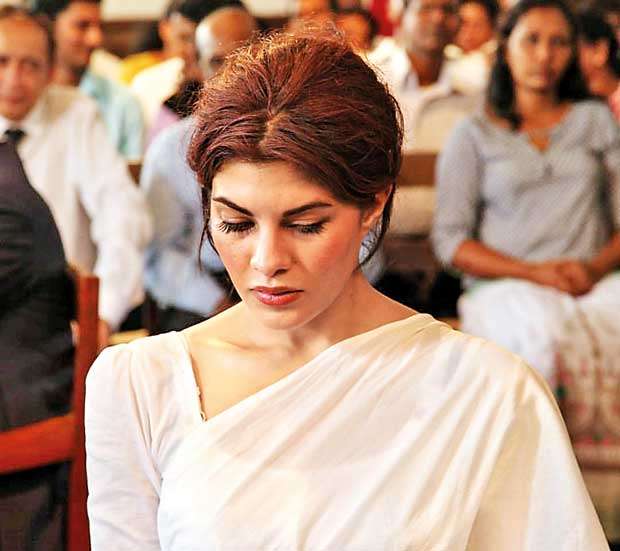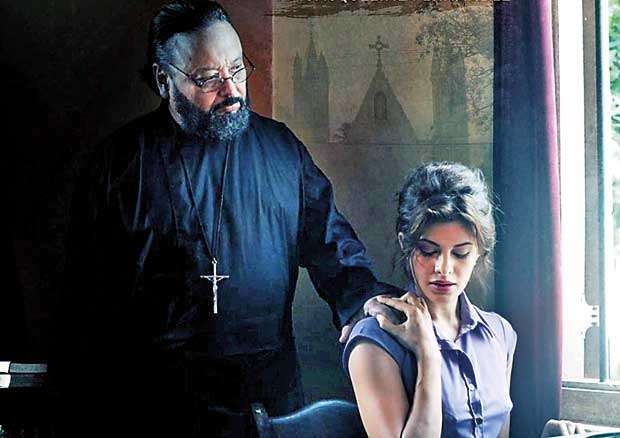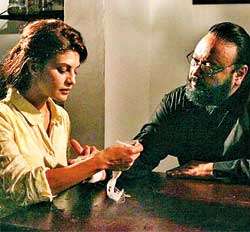27 Dec 2018 - {{hitsCtrl.values.hits}}

 Chandran Ratnam’s ‘Matthew’, based on Fr. Matthew Pieris/Dalrene Ingram trial in the late 1970s, is a relatively novel phenomenon to Sri Lankan film, films based on real life crime stories. The only previous precedents are Wasantha Obeysekara’s ‘Dadayama’, based on the Adlene Vitharana murder case which took place in 1959, and Titus Thotawatte’s “Haralakse’ based on the Turf Club robbery of 1948 and the murder of Armstrong Garage driver John de Silva. Then there were several, based on the lives of true life criminals and gangsters such as Maru Sira and Alfred de Soysa.
Chandran Ratnam’s ‘Matthew’, based on Fr. Matthew Pieris/Dalrene Ingram trial in the late 1970s, is a relatively novel phenomenon to Sri Lankan film, films based on real life crime stories. The only previous precedents are Wasantha Obeysekara’s ‘Dadayama’, based on the Adlene Vitharana murder case which took place in 1959, and Titus Thotawatte’s “Haralakse’ based on the Turf Club robbery of 1948 and the murder of Armstrong Garage driver John de Silva. Then there were several, based on the lives of true life criminals and gangsters such as Maru Sira and Alfred de Soysa.
Whereas Dadayama was in a contemporary setting, and the crucial murder scene was a wild fantasy far removed from the actual incident, ‘Matthew’ is filmed in a period setting, and the script follows the actual incidents as far as one can gather (the names are fictitious except in the case of Matthew Peiris). Fr. Peiris and his paramour Dalrene Ingram are played by Alston Koch and Jacqueline Fernandez. Koch is a pop singer now living in Australia, and it isn’t known if he’s got previous acting experience. Fernandez has made a breakthrough into Bollywood cinema, though this is her first experience acting in a Sri Lankan movie.
As for Ingram, her mind is a vacuum, making her look and sound stupid. That she may have been in awe of the friar is without any doubt
They carry it off, but just. The trouble is with the film’s script, which leaves a lot to be desired. I viewed the Sinhala version, not the English. But there is no reason to believe that language will make any difference as long as it’s the same script, which fails to give much depth to the character of a man with a diabolical mind and the charm of a devil.
As for Ingram’s character, Fernandez is ever the obliging wife of a nice, handsome man who gets murdered, and the equally obliging mistress of a madman in a friar’s cloak. Didn’t Dalrene Ingram have a mind of her own?
Matthew Peiris acquired a reputation as an exorcist, and toured other countries, including Australia, performing such rites. But this aspect of his life, a crucial element, is not given enough play in the film.
We see him performing just one exorcism, and that looks very unconvincing. Chandran Ratnam is an experienced film maker and it’s hard to understand this lacklustre approach towards what is a riveting real-life murder mystery.

The film picks up its pace after the murder of the friar’s wife, at which point the police investigation begins. However, the story as presented in the film, raises a fascinating question: did Dalrene Ingram actually know that Matthew Peiris was calculating and murdering her husband as well as his own wife, or was she a duped victim?
We have to assess the friar’s mind through those Bible passages he reads aloud. That doesn’t mean much to those who don’t know the Bible
 This is what the film seems to suggest. If so, her conviction and incarceration would be a miscarriage of justice. The police would have had no interest in proving her lack of culpability, even if they believed her to be a victim.
This is what the film seems to suggest. If so, her conviction and incarceration would be a miscarriage of justice. The police would have had no interest in proving her lack of culpability, even if they believed her to be a victim.
As for the defence lawyer, he was hired by the friar to defend both, when the prosecution assumed that both parties were guilty. He couldn’t have argued otherwise even if he believed Dalrene Ingram did not knowingly support the friar’s diabolical double-murder plan.
However, that might be, the script sounds bland much of the time. We have to assess the friar’s mind through those Bible passages he reads aloud. That doesn’t mean much to those who don’t know the Bible. As for Ingram, her mind is a vacuum, making her look and sound stupid. That she may have been in awe of the friar is without any doubt. He lorded over people and would have been her lord as much as her lover. But what did they talk about?
She was surrounded by people who distrusted and disliked the friar, but she seems to be blissfully unaware of his dark side. Without such raison d’etre, the film fails to be convincing.
As for Ingram’s character, Fernandez is ever the obliging wife of a nice, handsome man who gets murdered, and the equally obliging mistress of a madman in a friar’s cloak
The musical score works on and off, sometimes rising to the occasion and sometimes wandering away. The cinematography is effective without being remarkable, and one puzzling thing: the names of the main actors were given at the start, but the titles at the end seem to have missed something.
After a parade of producers, the names of technical staff and those scores of people who work to make a film failed to appear, as they usually do in a feature film.
30 Nov 2024 3 hours ago
30 Nov 2024 4 hours ago
30 Nov 2024 7 hours ago
30 Nov 2024 9 hours ago
30 Nov 2024 30 Nov 2024